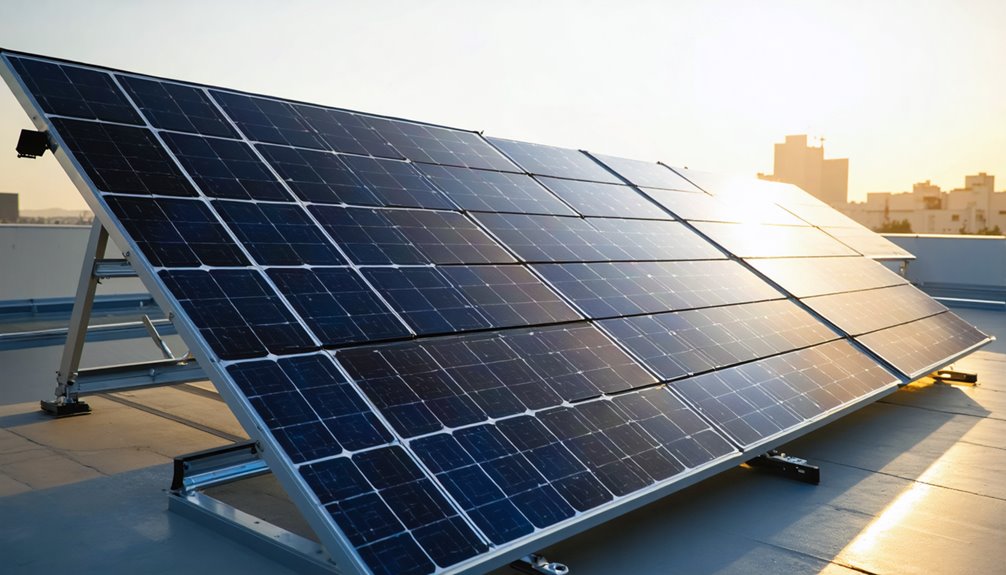You consider installing solar panels, but efficiency varies by material type, affecting your energy output and costs. Monocrystalline options boast high performance, while polycrystalline ones offer affordability. Thin-film panels suit flexible setups, and emerging perovskites promise breakthroughs. Yet, choosing the right one depends on more than just numbers—what factors tip the scales?
Key Takeaways
- Monocrystalline solar panels offer efficiencies ranging from 17% to 24%.
- Polycrystalline solar panels typically achieve efficiencies between 13% and 16%.
- Thin-film solar panels have efficiencies from 7% to 13%.
- Emerging perovskite materials can reach up to 27% efficiency in labs.
- Material type determines efficiency, with monocrystalline leading over polycrystalline and thin-film.
Monocrystalline Solar Panels

If you’re short on roof space but need maximum energy output, monocrystalline solar panels deliver with efficiency ratings of 17% to 24%. You get this edge because they’re crafted from single-crystal silicon, boosting electron mobility and energy conversion.
That means you generate more power in compact areas, with outputs ranging from 320 to 375 watts.
You’ll appreciate their durability too—they often come with 25-year warranties, ensuring reliable performance over time.
Sure, upfront costs run higher, but you slash long-term energy bills through superior efficiency.
When choosing, consult a reputable solar panel supplier to match panels to your setup. They’ll guide you on installation, helping you maximize savings and output without wasting space.
Polycrystalline Solar Panels
You notice that polycrystalline solar panels offer efficiency ratings between 13% and 16%, which fall short of monocrystalline panels due to their multi-crystal structure hindering electron flow.
You’ll appreciate their cost advantages, as the simpler manufacturing process keeps prices lower and makes them a budget-friendly choice for larger installations.
Consider their design features, like the speckled blue appearance from fused silicon fragments, which require more space to match the output of higher-efficiency alternatives.
Efficiency Ratings
You notice polycrystalline solar panels deliver efficiency ratings that typically range from 13% to 16%, offering a more affordable option than monocrystalline types despite their lower performance.
You’ll see this stems from their multiple silicon crystals, which hinder sunlight capture and conversion compared to single-crystal designs. As you evaluate your setup, remember these panels demand more space to match the energy output of higher-efficiency alternatives, so they’re not ideal if you’ve got limited roof area.
You’ll appreciate how manufacturing advances push some newer polycrystalline models toward 17% efficiency, closing the gap with monocrystalline tech.
When you install them, you’ll get reliable performance for everyday needs, balancing output with practicality in various applications.
Cost Advantages
While polycrystalline solar panels deliver efficiency ratings from 15% to 17%, they stand out for their budget-friendly pricing, often costing less than monocrystalline options.
You’ll find that you can save considerably on upfront costs, as the price gap has shrunk to about $0.05 per watt, making them ideal if you’re watching your budget.
You benefit from their lower average installation costs, thanks to a simpler manufacturing process that keeps things affordable without major hits to performance.
Even though they need more space for equivalent energy output due to slightly lower efficiency, you’ll appreciate how this suits larger setups where cost constraints matter most.
With proper installation and placement, you’ll meet your household’s energy needs effectively, enjoying substantial savings on your initial investment.
Design Features
Polycrystalline solar panels feature multiple silicon crystals melted together, creating their signature blue, marbled appearance and delivering efficiency ratings between 15% and 17%. You’ll appreciate how this design stems from a less energy-intensive production process, where you melt silicon fragments into blocks, then slice them into wafers. This makes the panels more affordable, but you’ll need more space to install them for equivalent output compared to monocrystalline types, since their efficiency lags slightly.
You should consider temperature impacts too; these panels handle moderate climates well, but high heat reduces their performance more noticeably. Typically, you connect them to string inverters, which might lower system efficiency versus microinverters.
To compare key design aspects, examine this table:
| Design Feature | Details |
|---|---|
| Appearance | Blue, marbled from multiple crystals |
| Production Process | Less energy-intensive, cost-effective |
| Space Requirements | Higher for same energy output |
| Temperature Performance | Adequate in moderate heat, drops in high |
| Inverter Connection | Usually string inverters, reduced efficiency |
Thin-Film Solar Panels
You notice thin-film solar panels boast efficiency ratings between 10% and 13%, marking them as the least efficient among major types, though they excel in high-heat conditions.
You’ll appreciate their cost advantages, since the less energy-intensive production process keeps initial prices lower than crystalline options.
You gain from their flexibility benefits, as materials like cadmium telluride or amorphous silicon enable lightweight, bendable designs for unique installations.
Efficiency Ratings
Thin-film solar panels deliver efficiency ratings from 10% to 13%, ranking them as the least efficient among monocrystalline and polycrystalline options.
You’ll notice that you get less power output per square foot, so you need more space to generate the same energy as higher-efficiency panels.
But don’t overlook their perks—you’ll appreciate their lightweight and flexible design, which lets you install them easily in diverse spots, like portable setups or curved surfaces.
In high temperatures, you’ll see they perform better than crystalline types, maintaining output when others falter.
However, you should know they degrade faster, often with warranties of just 15 to 20 years, so factor that into your long-term plans.
Cost Advantages
Affordability drives the appeal of thin-film solar panels, as they cost less than monocrystalline or polycrystalline types thanks to simpler manufacturing. You’ll find these panels are the most cost-effective option, with prices considerably lower, reducing your initial investment.
If you’re budget-conscious, they’re especially attractive for larger installations where you’ve got abundant space.
Although thin-film panels offer lower efficiency ratings around 10-13%, you can compensate by covering a bigger area. Their affordability lets you install more panels, boosting total energy generation without breaking the bank.
You’ll also save on installation thanks to their lighter weight, which simplifies the process and cuts costs, even in spots where heavier panels aren’t practical.
Despite any performance concerns, you gain a strategic edge with thin-film’s lower upfront costs, ideal for large-scale or commercial projects where budgets tighten.
Flexibility Benefits
Beyond their budget appeal, thin-film solar panels excel with a lightweight and flexible design that adapts to curved or irregular surfaces. You’ll find you can install them on rooftops, vehicles, or portable devices where rigid crystalline panels won’t fit.
This versatility opens up applications in unconventional spaces, even if their efficiency ranges from 10% to 20%—lower than traditional options.
You benefit from their performance in high-heat environments, thanks to favorable temperature coefficients that keep output steady in warmer climates.
While they demand more space to match crystalline panels’ power, requiring full roof coverage for ideal results, their simpler manufacturing process keeps costs low.
You get a practical choice for large-scale or flexible setups without breaking the bank.
Emerging Perovskite Materials
Perovskite solar cells emerge as a promising technology, achieving efficiencies of up to 27% in lab settings.
You’ll discover these materials could reach 40% efficiency with ongoing research, easily outpacing traditional silicon panels.
You benefit from their lower manufacturing costs, thanks to straightforward production methods and plentiful raw materials that make them more affordable than conventional options.
You’ll appreciate the flexibility of perovskite cells, which lets you integrate them into building materials or use them as lightweight panels for portable applications.
This versatility opens up new possibilities for solar energy in everyday settings.
Although they offer high efficiency, you’ll note challenges with stability and durability, but researchers actively tackle these issues to improve long-term performance.
Factors Influencing Material Efficiency
Several factors influence solar panel efficiency, with material type leading the way. You’ll find that monocrystalline panels, crafted from pure silicon, deliver efficiencies of 17% to 24%, while polycrystalline ones range from 13% to 16%.
If you’re considering thin-film options, expect lower rates of 7% to 13%, which means you’ll need bigger setups for similar output due to their manufacturing and structure.
You’re also eyeing advances like perovskite materials, which could push efficiencies up to 40% through innovative choices.
Beyond materials, external elements play a role; you optimize silicon-based cells at around 25°C (77°F), where temperature and solar irradiance directly impact performance. Don’t overlook anti-reflective coatings—you apply them to boost sunlight absorption and cut reflection losses, enhancing overall efficiency. For residential installations aiming at peak performance, selecting Tier-1 solar panels ensures superior quality and longevity.
Comparing Efficiency Across Types
How do the efficiencies of various solar panel types compare when you need to choose the right one?
You’ll find monocrystalline panels lead with 18% to 24% efficiency, thanks to their pure silicon that maximizes output in limited spaces.
You opt for polycrystalline ones if you’re budget-conscious; they deliver 13% to 16% efficiency from multiple silicon crystals, but they’re less effective than monocrystalline.
You might consider thin-film panels for their low cost, though their 7% to 13% efficiency means you’ll need bigger setups to generate enough power.
Emerging perovskite cells excite you with up to 27% efficiency, promising big advancements, but they’re not yet ready for broad use.
You guarantee fair comparisons using standard test conditions (STC), controlling temperature at 25°C and irradiance at 1000W/m².
Conclusion
You’ve explored how monocrystalline panels deliver top efficiency at 17-24%, while polycrystalline offer affordability at 13-16%. Thin-film suits large areas despite 10-13% rates, and perovskites promise up to 27%. Factors like space and budget shape your choice. When you compare, remember efficiency impacts output—pick monocrystalline for limited roofs, or polycrystalline for value. You’re now equipped to select the best material for your solar setup, boosting energy savings and sustainability.


